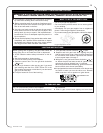Special offers from our partners!

Find Replacement BBQ Parts for 20,308 Models. Repair your BBQ today.

W415-0530 / 12.14.05
6
INSTALLING IN AN UNVENTED APPLICATION
This heater shall not be installed in a confined space or
unusually tight construction unless provisions are pro-
vided for adequate combustion and ventilation air.
In order to avoid the possibility of exposed insulation or
vapour barrier coming in contact with the fireplace body,
it is recommended that the walls of the fireplace enclo-
sure be 'finished', (i.e. drywall/sheetrock) as would any
other outside wall of the home. This will ensure that
clearance to combustibles is maintained within the cav-
ity.
The National Fuel Gas Code, ANSI Z223.1 defines a con-
fined space as a space whose volume is less than 50 cubic
feet per 1,000 Btu per hour (4.8 m
3
per kW) of the aggregate
input rating of all appliances installed in that space and an
unconfined space as a space whose volume is not less than
50 cubic feet per 1,000 Btu per hour (4.8 m
3
per kW) of the
aggregate input rating of all appliances installed in that space.
Rooms communicating directly with the space in which the
appliances are installed, through openings not furnished with
doors are considered a part of the unconfined space.
The GVFL18/24/30 are all rated at 40,000BTUs
per hour and therefore requires a minimum
unconfined space of 2,000 cubic feet.
To determine the volume of the room where the heater is to
be installed, multiply the width x the length x the ceiling height
of that room measured in feet. If any adjoining rooms are
connected by grills or openings such as kitchen pass-
throughs, etc., the volume of those rooms may be added to
the total.
Multiply the room volume by 1000 and divide this amount by
50 to determine the maximum Btu/hr that the space can sup-
port with adequate combustion and ventilation air.
Add the Btu/hr of all fuel burning appliances located within
the space such as gas furnace, gas water heater, etc. Do
not include direct vent gas appliances which draw their input
and output air from and to the outdoors.
WARNING: If the area in which the heater may be oper-
ated is smaller than that defined as an unconfined space or
if the building is of unusually tight construction, provide ad-
equate combustion and ventilation air by one of the meth-
ods described in the National Fuel Gas Code ANSI Z223.1,
Section 5.3 or the applicable local code.
figure 1
Room Volume = Length x Width x Height
Max BTU/hr = Room Volume x 1000 ÷ 50
If for example,
the length of the rooms is 10 feet,
the width of Room 1 is 10 feet,
the width of Room 2 is 15 feet
the height of the rooms is 8 feet.
The volume of Room 1: 10 x 10 x 8 = 800 cubic feet.
The volume of Room 2: 10 x 15 x 8 = 1200 cubic feet.
If in this example a solid door separates Room 1 from Room
2, the volume of Room 2 could not be used. In this case the
maximum BTU/h would be:
Maximum BTU/h:
800 x 1000
= 16,000 BTU/h
This would be considered a confined space since it can not
support the 30,000BTU/h input of the heater and it would be
necessary to provide adequate combustion and ventilation
air to Room 1.
In this example, because there is no door to the adjoining
room, the volume of the adjoining room may be added to the
volume of the room with the heater to get a total unconfined
space.
The total unconfined space: 800 + 1200 = 2000 cubic feet.
Maximum BTU/h:
2000 x 1000
= 40,000 BTU/h
If there are no more fuel burning appliances within this space
then the 30,000 BTU/h input of the fireplace is suitable to be
installed. This also assumes that the construction of this
space is not unusually tight.
50
50
COMBUSTION & VENTILATION
AIR PROVISIONS
DETERMINING CONFINED OR UNCONFINED
SPACE
EXAMPLE 1
EXAMPLE 2
ROOM 2
ROOM 1
HEIGHT
WIDTH
LENGTH
WARNING
Barriers such as the bottom of a glass door frame placed in front of a gas log set can change the air flow
characteristics of the fireplace which in turn can cause the unit to carbon or overheat and malfunction.














